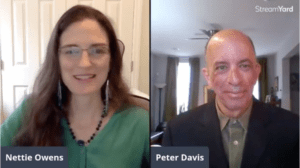What do we need to know right now about content as currency?
“Content is king” is the old way of things. We don’t live in a monarchy anymore. And there are queens, such as yourself, that are doing boss things. So, I think that’s the old mentality of just one person sitting on the throne.
“Content is currency” is really about what you’re doing right now. You’re bringing up counter people, such as myself and others, to tell people what’s going on in business. That’s a timeshare, and we look at time as a form of currency. Because you are sharing, you’re giving up a trade. It’s almost a barter system. And in that barter system, you’re giving information.
Now we’re seeing currency being put in place to build an audience. A lot of currency that we’re giving, like at Black In Sports, is in the form of providing a platform for voices that are usually marginalized and not heard – and then providing a positive spin on those platforms. You’ve heard people say, “Shut up and dribble,” when speaking about social justice issues that are happening, but you don’t get the entire side. These people have more than just that one myopic look or voice.
Content is currency – not only from podcasts but all social channels where people are giving that free content. And it seems like it’s free, yes, but it is that currency that I’m giving you. I’m providing you with something in hopes that you will join my fan club or you will join my tribe. I’m giving you currency to something that will either make you better or grow your knowledge base. It’s something that I’m offering you and hoping that you’ll either buy my wares or listen to what I’m a knowledge expert in.
“Have you thought about your content as being a form of currency? It’s a trade of information and expertise. It creates the ability to contact and be in touch with somebody and allows for a dialogue from there.”
Are there businesses that are doing this well?
Some big brands are doing it well. For example, I don’t know if you noticed or recall Popeye’s chicken sandwich ad campaign. When that came out, Chick-Fil-A and Wendy’s, got into a battle about whose chicken sandwich is the best.
Some people are good on specific topics, and they do it well. A couple of wine brands are good on social media, and I think it’s due to them being in tune. They are giving that time and that currency – because the audience is the biggest thing for anyone. I don’t care if it’s the coffee you drink. When you reach out to that company, and you tag them in something you say, and they respond to you – that’s currency that you received from your client for your customer. And people that have these Twitter feeds, Instagrams, and TikToks – and don’t respond – that’s a lost currency.
“It’s not just that you’re putting content out, but it’s that you are responding as well. So if we go with this idea that content is currency, you’re essentially throwing this money out here and letting it fall when you don’t engage.”
Where should we be putting our focus on building content currency?
That’s a tricky question, and you’re probably not going to like my answer.
You should focus on where you are receiving the love – so where your currency is most valued if we’re going to play on that currency thought process.
Because there are so many platforms, it can cause a problem.
And the problem is you do not have to be everywhere. You don’t need to be on YouTube, on a podcast, on TikTok, on Clubhouse – the list can go on of all the mediums.
Now, I do recommend going to those platforms, peeking around, and seeing if that would be an avenue for you. But I say pick the three that you want to be most impactful on – and the audience will tell you where you should be.
So, our podcast is on your traditional podcast channels, but we are also on YouTube. So, for us, it was a poignant place because the concept of Black In Sports is showing a face that’s not traditionally shown. And representation matters.
We talk about it not just as the minority community, but as gay and lesbian, women’s rights, and all of this stuff because the representation matters. We’re on YouTube so people can see and say, “Oh my gosh, the director of T-Mobile Guest Services is a black female. That’s amazing.” I can see that. And that’s why YouTube makes sense for us.
Instagram is another place for us. It’s a very visual component. And I think about who I deal with mainly, and they have visual representations. For example, most athletes are on Twitter and Instagram, and that’s where they’re living their life.
Now you have a couple of athletes like Juju who’s taken TikTok by storm. But he’s into different realms like Twitch because he’s a video gamer.
Twitch is a streaming video gaming platform, and you would probably want to spend time there as well if you’re a gamer.
I think that was a very, very long-winded answer to say, go to where your market is and where your audience is.
“I love the idea of testing different platforms to see what works for you. I think a lot of times, as business owners, we fall into this trap of, “Oh, this Guru has said that you can find your customers on Facebook.” But did you go and look to see if they’re there? Did you try it out? It’s imperative to do that due diligence.”
3 Action Steps
1. Think about the content you are creating as currency that you are bartering to gain followers who may become clients or customers because of the value you provide.
2. When creating content, put your focus on where you are making the most impact.
3. Investigate the different social media platforms and spend time on the three where you see the best results.
Connect with EJ Cutliff on LinkedIn.
Please comment below. I would love to hear from you.














No comments yet.